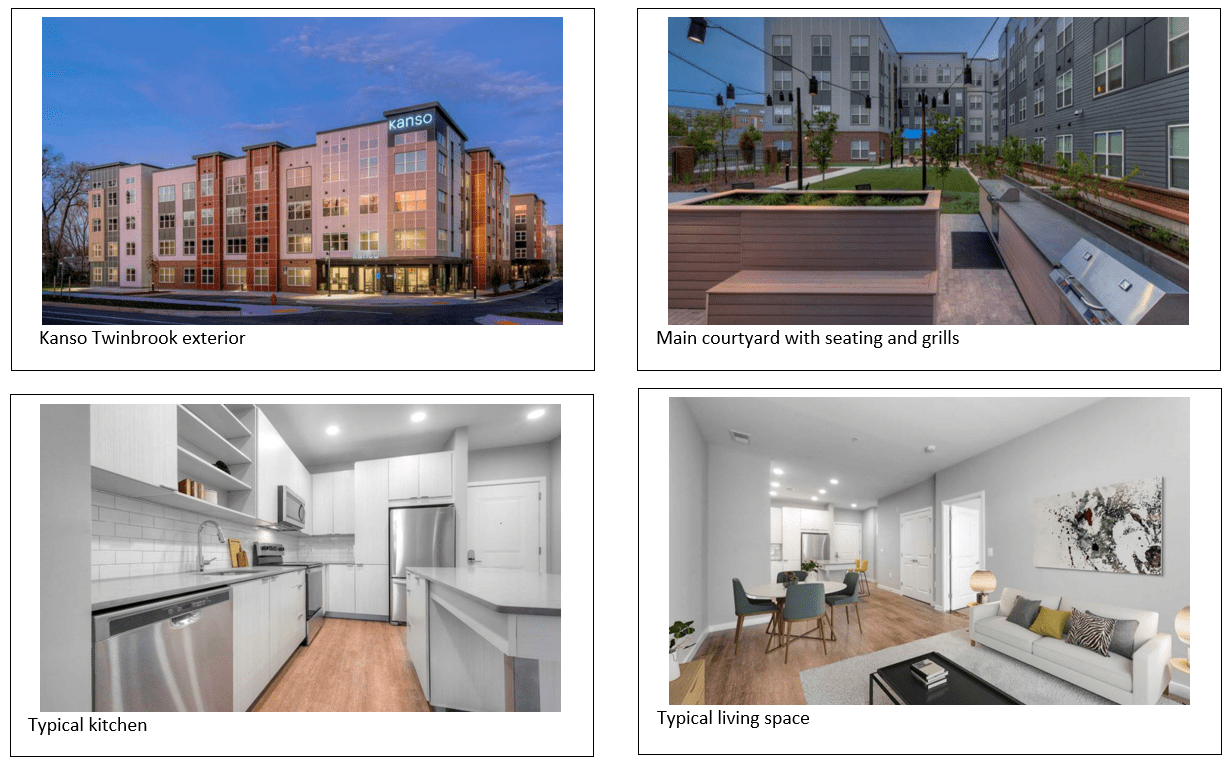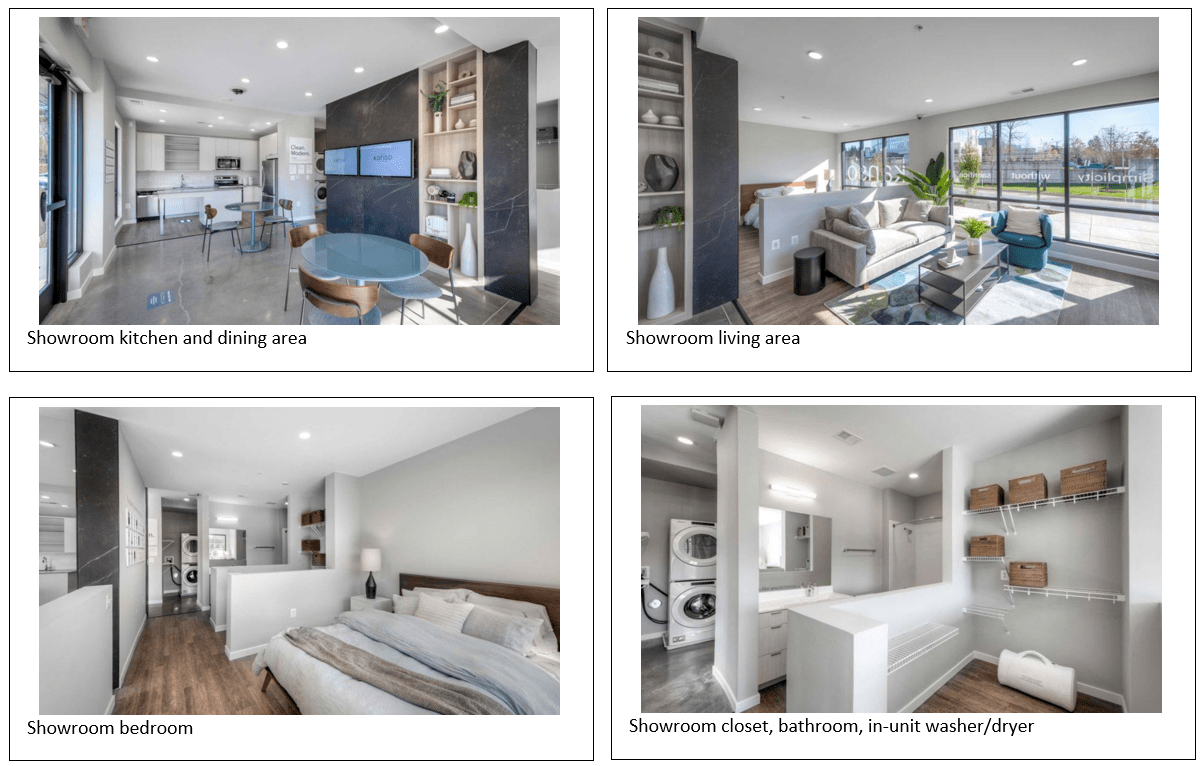In terms of affordability, one tends to think of the dichotomy between luxury apartment buildings that offer ample community amenities and federally or state subsidized “low-income” units. However, there is an additional cohort of people within the affordability spectrum that fall between high-priced luxury units and subsidized units within the United States. Avalon Bay Communities (AVB) has designed a new building type branded “Kanso”, which caters to tenants between the income extremes of the housing sector by designing a technology-first building that focuses on operational cost savings that can be passed on to tenants. The first of these buildings is called Kanso Twinbrook, and is located in the Twinbrook neighborhood of Rockville, Maryland.
Kanso Twinbrook opened in December 2020 and operates as a “self-serve” community. The property has no elevators, no full-time on-site staff, and limited community amenities. The property is one of the first buildings in the residential sector to implement the Works With Latch program and Google Nest, which allows AVB to integrate building accessibility features in addition to utilities for its tenants. Customer service for the building is available entirely virtually through AVB’s call center, regular maintenance visits are scheduled a few times per week, and residents can call for emergency maintenance as needed. The leasing process at the building is also fully automated, with the first floor of the building operating as a show room for potential tenants who are given a short-term access code to walk through the show unit.

To better understand the concept and design of Kanso Twinbrook, we spoke with Karen Hollinger, Senior Vice President of Strategic Initiatives at AVB. Ms. Hollinger is responsible for leading large multi-year strategic initiatives for AVB. Prior to her current position, Ms. Hollinger led the digitization of construction, development, and asset management for AVB’s multi-billion-dollar development pipeline. The following details a summary of our discussion with Ms. Hollinger, which has been edited and paraphrased for clarity.
Question:
How long has the Kanso product design been in the works at AVB?
Answer:
AVB has been brainstorming and developing the idea for about five years. The goal of the Kanso design is to build a Class A product that can be built at a lower cost and maintained at a lower operating cost over the lifetime of the asset.
Question:
Can you speak to the types of costs you identified that could be substantially lowered when developing this building?
Answer:
Ms. Hollinger spoke to first identifying costs that could not be controlled based on the type of product, demographic targeted, or type of building design. These non-controllable costs mainly consist of land, taxes, and insurance. Ms. Hollinger added that in the market today, because land prices, taxes, and insurance costs are so high, developers typically need to charge rents at high price points to make a profit. The result of high-priced units has led to the “amenity war” we are seeing play out across many metros in the U.S. Once Ms. Hollinger and her team understood the expenses they were unable to control, they focused on those that they could control, by utilizing high tech products. The two main categories of costs that could be dramatically lowered by utilizing technology were utilities and staffing.
Question:
How does the building design and use of technology help keep utility and staffing costs low?
Answer:
The main drivers of high utility costs come from common spaces, elevators, pools, and gyms. Thus, to control these expenses, Ms. Hollinger and her team decided to eliminate these amenities from the building entirely to control the utility costs associated with common spaces. In order to keep staffing costs low, AVB paired with property technology companies like Latch to implement smart home solutions that limit the need for a full-time on-site staff. Further, Ms. Hollinger explained that one of the more management-intensive roles at an apartment complex is leasing tours. The partnership with Latch allows tours to be conducted without any on site staff. Potential tenants are able to access the building via a one-time code where they can tour the property’s model units that are located on the ground floor of the building where you would typically find a leasing center or concierge desk at other luxury apartment buildings.

Question:
Who is the target demographic for the Kanso product type and how did AVB identify them as a group of underserved renters?
Answer:
AVB conducted research and analysis on customers that were not being directly targeted but were still a large renting sector. In their research, Ms. Hollinger and her team identified a group of young adults that AVB categorized as “young careerists”. Young careerists are 23 to 29 years of age with approximately two to seven years of work experience. AVB identifies the young careerists as people who do not want to live with roommates and prefer to have in-unit washer and dryers. Additionally, young careerists are typically priced out of living in many major cities where they might have to pay upwards of $3,000 for a one-bedroom unit. AVB decided to enhance their focus on the young careerists due to the large number of renters in this segment. As a result, the Kanso product type is designed specifically to provide units for the young careerist renter.
Question:
What aspects of Rockville, Maryland make it a good fit for the Kanso product?
Answer:
Rockville, but more specifically the neighborhood of Twinbrook, has two main types of housing, which include the highly amenitized luxury buildings built within the last five years, and buildings built in 1965 or earlier with shared laundry rooms. When Ms. Hollinger and the AVB team identified the gap in Twinbrook’s housing market, they began to analyze the demographics of the area further. In addition to the “missing middle” housing gap, Twinbrook has low crime statistics and a large number of recently graduated “young careerists” within the biomedical field. Additionally, Kanso Twinbrook is located within a five-minute walk from the Twinbrook subway station, which connects the site to the downtown D.C. area. Overall, the combination of these factors made Twinbrook an excellent location for the Kanso model.
Question:
Can you discuss the success of the lease-up process and any surprises or challenges the property has faced so far?
Answer:
The property completed lease-up on schedule and most underwriting projections are being met at the property. According to Ms. Hollinger, the technology at Kanso Twinbrook has operated smoothly and, as of the date of our conversation, there have not been any operational surprises so far.
We want to thank Ms. Hollinger for sharing her insights regarding the Kanso Twinbrook development. At the present, there are no public plans to scale the Kanso product type for AVB; however, we are looking forward to tracking the success of Kanso Twinbrook and potential expansions moving forward.
